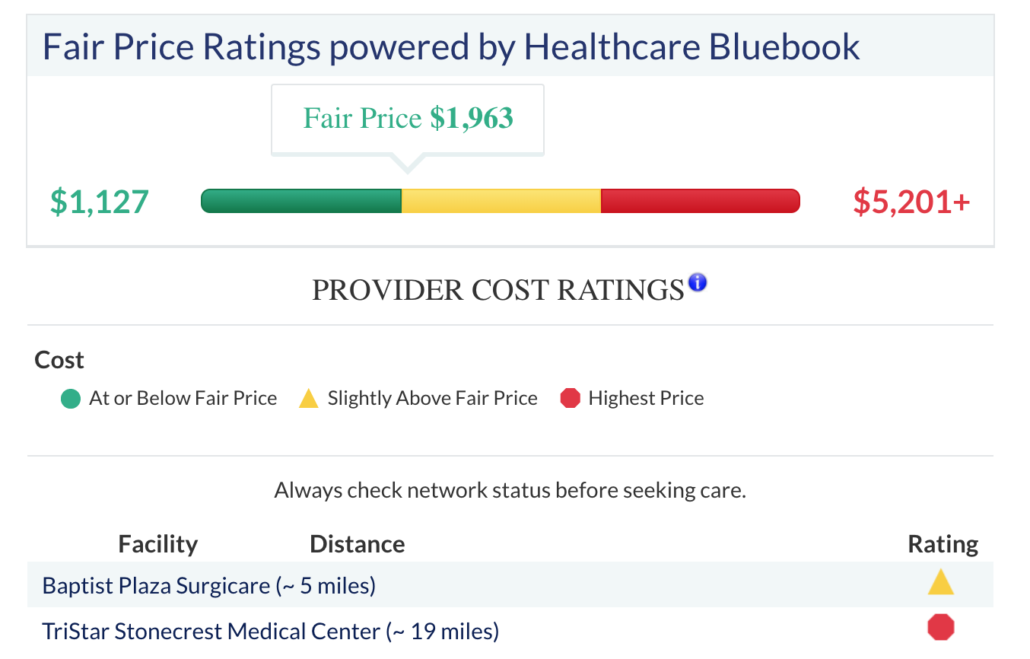GASTROENTEROLOGY ENDOSCOPY CENTER
OUR PROCEDURES
OUR PROCEDURES
Thank you for your interest in learning more about your upper endoscopy. In the sections that follow, we will provide you with detailed information on the procedure, how it’s performed and why it’s important.
We realize that our patients are responsible for more of the cost of their own health care. We are a Valued-Certified provider powered by Healthcare Bluebook, providing area pricing information to help you spend your money wisely. While this pricing information does not represent an offer of a specific price, it can help you make a better, value-based, health care decision. Click here to learn more or request an appointment.

Results are customized to the zip code: 37205
The “Fair Price” is Healthcare Bluebook’s recommended price for a given health care service based on the amount providers typically accept as payment from insurance companies. As a Value Certified Provider, Healthcare Bluebook has independently verified that our prices generally fall at or below this amount. It does not, however, guarantee a particular price. Please check the provider’s network status and price before making an appointment.
An upper endoscopy, also known as esophagogastroduodenoscopy (EGD), is a procedure used to determine the cause of gastrointestinal disorders and symptoms including heartburn, Barrett’s esophagus, the presence of hiatal hernias, the cause of abdominal pain, unexplained anemia, and the cause of swallowing difficulties, upper GI bleeding, and the presence of tumors or ulcers. An upper endoscopy lets your doctor examine the lining of the upper part of your gastrointestinal tract, which includes the esophagus, stomach and duodenum (first portion of the small intestine).
This procedure is the best option for a physician to determine the cause of bleeding in the upper gastrointestinal tract, and it is also more accurate than an x-ray for detecting inflammation, ulcers and tumors of the esophagus, stomach and duodenum. Your doctor might use upper endoscopy to obtain a biopsy (small tissue samples) to distinguish between benign and malignant (cancerous) tissues.
Preparing for an Upper Endoscopy
Your doctor will give you specific instruction to follow to prepare for your upper endoscopy. Generally, because an empty stomach allows for the best and safest examination, you will be instructed to not eat or drink, with the exception of water, for approximately six hours before your procedure.
What Happens During an Upper Endoscopy?
You will lie on your left side, and an intravenous (IV) sedation is used during an upper endoscopy. Once the sedation takes effect your doctor will pass a lighted, flexible endoscope into your mouth. A plastic mouth guard is usually used to protect the endoscope from your teeth. A tiny camera at the tip of the endoscope will transmit images to a monitor for your physician to view. If your physician is using tools to obtain a biopsy, he/she will use the monitor to guide the tools used.
At the end of the exam, the endoscope is slowly withdrawn. The procedure takes about five to 20 minutes, depending on why the test is being performed and what your physician finds.
What Happens After an Upper Endoscopy?
Immediately following an upper endoscopy, you will spend some time resting in recovery while the sedation medication, if used, wears off. Upper endoscopy is performed as an outpatient procedure, so you can have your procedure in an ambulatory surgery center, which can provide better accessibility and ease compared to a hospital.
Once home, some patients report symptoms of bloating, cramping or a sore throat, but these symptoms should be mild and improve with time. Contact your doctor if your symptoms do not improve.
What are the Outcomes with Upper Endoscopy?
The timeframe it will take for you to receive results from your upper endoscopy will be determined by your situation. If a tissue sample was collected, it may take a few days for the testing laboratory to return your results to your physician. Ask your doctor when you can expect to hear your results.
